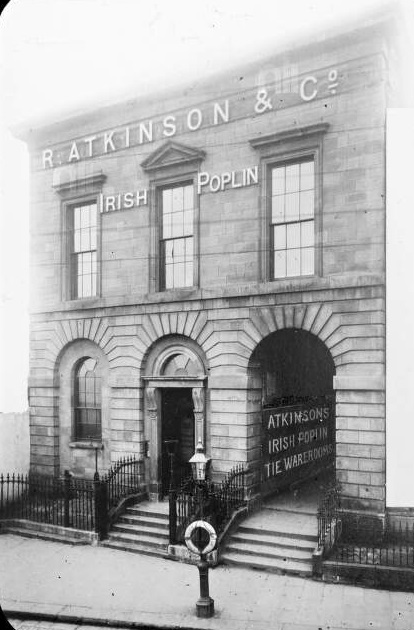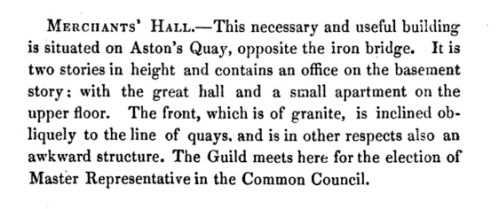
R. Atkinson & Co, Irish poplin manufacturers (Image: National Library of Ireland)
Like many Dubliners, I pass through Merchants’ Arch a few times a week, normally in a hurry somewhere. Connecting Liffey Street and the Temple Bar district via the Ha’penny Bridge, the archway even pops up in Ulysses, as Leopold Bloom searches for a (rather naughty) book for his beloved Molly. Much has changed since the time of Bloom, but there are still people selling goods in the Arch from time to time, not to mention buskers and long-established businesses.
Like much of what is beautiful and old about the city today, the Wide Streets Commission is to thank for this arched passage, insisting on it as a necessary thoroughfare. Established by an Act of Parliament in 1757, this body reshaped Dublin as the people knew it, creating networks of new streets and leading Dublin into a new era. As the masterful study Dublin Through Space and Time notes, “the Wide Streets Commissioners brought a truly European vision of urban design to Dublin.” So many of the streets we enjoy today – Parliament Street, D’Olier Street, Westmoreland Street – are part of the vision of this body.
Merchants’ Arch forms a part of the Merchants’ Hall, built to the designs of the celebrated architect Frederick Darley in 1821. Today occupied by a public house and restaurant, the building was constructed for the use of the Merchant’s Guild, who originally had their premises at the Tailors Hall in Back Lane, near to Christchurch Cathedral. In the eighteenth century and well into the nineteenth, Dublin was home to a number of Guild Halls which reflected industry in the city. The Tailors’ Hall and Merchants’ Hall were joined by Weavers’ Hall in the Coombe and the Bricklayers Hall on Cuffe Street. As Frank Hopkins has noted, it seems almost every group of skilled Dublin workers were represented by a Guild. He points towards “the Goldsmiths Guild, the Guild of Carpenters, Millers, Masons and Heliers, the Cooks and Vintners Guild, and the Guild of Tallow Chandlers….”, not to mention “the Guild of Barber-Surgeons and Apothecaries”.

A contemporary description of the new Merchants’ Hall.
Depictions of Merchants’ Arch historically have been less than flattering; take William Orpen’s painting ‘The Knackers Yard’ from 1909. It depicts a rundown and shabby passage. Notice what appears to be the royal coat of arms above the archway itself. The passage continued to excite Dublin artists in subsequent decades, with Harry Kernoff among the other artists to depict it.

William Orpen’s ‘The Knackers Yard,1909’. Image credit.
Following the disbandment of the Merchant’s Guild, the hall served a number of purposes in subsequent decades, with historian Maurice Curtis noting that these roles “included a shirt-and-poplin factory…and a Protestant boys school.” The name R. Atkinson & Co adorned the building during its time as a poplin factory.
One figure associated with the archway was Thomas Traynor, originally from Tullow in Carlow. An active member of Irish Volunteers and later the Irish Republican Army, he was executed in Mountjoy Prison in 1921, following his capture for involvement in a raid on Crown Forces. Traynor ran a shoe and boot repair company in the archway. There was a lot of activity in the area during the War of Independence, with a secret IRA munitions factory at Crown Alley (beside what is now the Bad Ass Cafe) producing grenades.
In the decades following independence, Merchants’ Arch became synonymous with book sellers, bric-a-brac and the like. Embodying this spirit was the ‘Old Curiosity Shop’, run by Ted Keogh, which for more than 20 years sold just about everything. Ted sold “antiques, cut glass, books, oil paintings and boxing and racing prints.” Other businesses who came to call it home included Matthew and Sons Antiques, Oman’s Books and Mojo Records.

Browsing in Merchants’ Arch, c.1960s (Image: National Library of Ireland)
One curious little feature of the arch is a memorial plaque to Phil Lynott, commemorating his music video for Old Town, some of which was shot on the nearby Ha’penny Bridge. The Arch has long been associated with Dublin buskers, some of whom make an appearance in this Éamonn MacThomáis feature from 1983. Like so much of the output he left behind, the MacThomáis piece is important to historians and researchers today, as he walks right through Merchants’ Arch and talks of the various businesses present.
Today, Merchants’ Arch is home to businesses including Mojo Records, China Blue shoes and much more besides. Last year, two people were injured when some of the historic fabric of the arch collapsed. While much has changed in the area around the archway, it remains a hive of activity in the heart of the city.

Looking up Merchants’ Arch from Crown Alley (Image: RTÉ Archives, from Éamonn MacThomáis footage)

 Click on the book for more.
Click on the book for more. Click on the book for more.
Click on the book for more.
[…] Merchants’ Arch Through Time. […]
Wonderful article. I passed through the archway many times throughout my life and never really thought about the history of this lovely building and archway. Your article now solves that problem, many thanks.